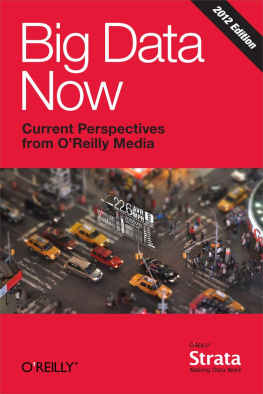Chapter 1. Introduction
Chapter 2. Getting Up to Speed with Big Data
What Is Big Data?
By Edd Dumbill
Big data is data that exceeds the processing capacity of conventional database systems. The data is too big, moves too fast, or doesnt fit the strictures of your database architectures. To gain value from this data, you must choose an alternative way to process it.
The hot IT buzzword of 2012, big data has become viable as cost-effective approaches have emerged to tame the volume, velocity, and variability of massive data. Within this data lie valuable patterns and information, previously hidden because of the amount of work required to extract them. To leading corporations, such as Walmart or Google, this power has been in reach for some time, but at fantastic cost. Todays commodity hardware, cloud architectures and open source software bring big data processing into the reach of the less well-resourced. Big data processing is eminently feasible for even the small garage startups, who can cheaply rent server time in the cloud.
The value of big data to an organization falls into two categories: analytical use and enabling new products. Big data analytics can reveal insights hidden previously by data too costly to process, such as peer influence among customers, revealed by analyzing shoppers transactions and social and geographical data. Being able to process every item of data in reasonable time removes the troublesome need for sampling and promotes an investigative approach to data, in contrast to the somewhat static nature of running predetermined reports.
The past decades successful web startups are prime examples of big data used as an enabler of new products and services. For example, by combining a large number of signals from a users actions and those of their friends, Facebook has been able to craft a highly personalized user experience and create a new kind of advertising business. Its no coincidence that the lions share of ideas and tools underpinning big data have emerged from Google, Yahoo, Amazon, and Facebook.
The emergence of big data into the enterprise brings with it a necessary counterpart: agility. Successfully exploiting the value in big data requires experimentation and exploration. Whether creating new products or looking for ways to gain competitive advantage, the job calls for curiosity and an entrepreneurial outlook.
What Does Big Data Look Like?
As a catch-all term, big data can be pretty nebulous, in the same way that the term cloud covers diverse technologies. Input data to big data systems could be chatter from social networks, web server logs, traffic flow sensors, satellite imagery, broadcast audio streams, banking transactions, MP3s of rock music, the content of web pages, scans of government documents, GPS trails, telemetry from automobiles, financial market data, the list goes on. Are these all really the same thing?
To clarify matters, the three Vs of volume, velocity, and variety are commonly used to characterize different aspects of big data. Theyre a helpful lens through which to view and understand the nature of the data and the software platforms available to exploit them. Most probably you will contend with each of the Vs to one degree or another.
Volume
The benefit gained from the ability to process large amounts of information is the main attraction of big data analytics. Having more data beats out having better models: simple bits of math can be unreasonably effective given large amounts of data. If you could run that forecast taking into account 300 factors rather than 6, could you predict demand better? This volume presents the most immediate challenge to conventional IT structures. It calls for scalable storage, and a distributed approach to querying. Many companies already have large amounts of archived data, perhaps in the form of logs, but not the capacity to process it.
Assuming that the volumes of data are larger than those conventional relational database infrastructures can cope with, processing options break down broadly into a choice between massively parallel processing architecturesdata warehouses or databases such as Greenplumand Apache Hadoop-based solutions. This choice is often informed by the degree to which one of the other Vsvarietycomes into play. Typically, data warehousing approaches involve predetermined schemas, suiting a regular and slowly evolving dataset. Apache Hadoop, on the other hand, places no conditions on the structure of the data it can process.
At its core, Hadoop is a platform for distributing computing problems across a number of servers. First developed and released as open source by Yahoo, it implements the MapReduce approach pioneered by Google in compiling its search indexes. Hadoops MapReduce involves distributing a dataset among multiple servers and operating on the data: the map stage. The partial results are then recombined: the reduce stage.
To store data, Hadoop utilizes its own distributed filesystem, HDFS, which makes data available to multiple computing nodes. A typical Hadoop usage pattern involves three stages:
- loading data into HDFS,
- MapReduce operations, and
- retrieving results from HDFS.
This process is by nature a batch operation, suited for analytical or non-interactive computing tasks. Because of this, Hadoop is not itself a database or data warehouse solution, but can act as an analytical adjunct to one.
One of the most well-known Hadoop users is Facebook, whose model follows this pattern. A MySQL database stores the core data. This is then reflected into Hadoop, where computations occur, such as creating recommendations for you based on your friends interests. Facebook then transfers the results back into MySQL, for use in pages served to users.
Velocity
The importance of datas velocity the increasing rate at which data flows into an organization has followed a similar pattern to that of volume. Problems previously restricted to segments of industry are now presenting themselves in a much broader setting. Specialized companies such as financial traders have long turned systems that cope with fast moving data to their advantage. Now its our turn.














